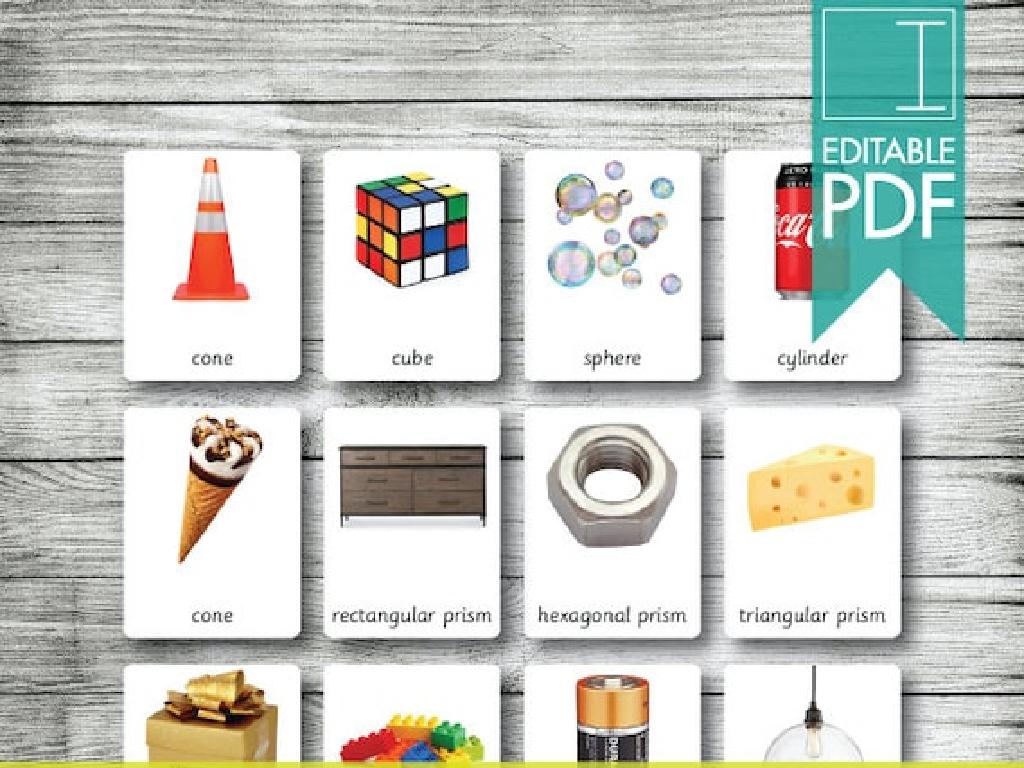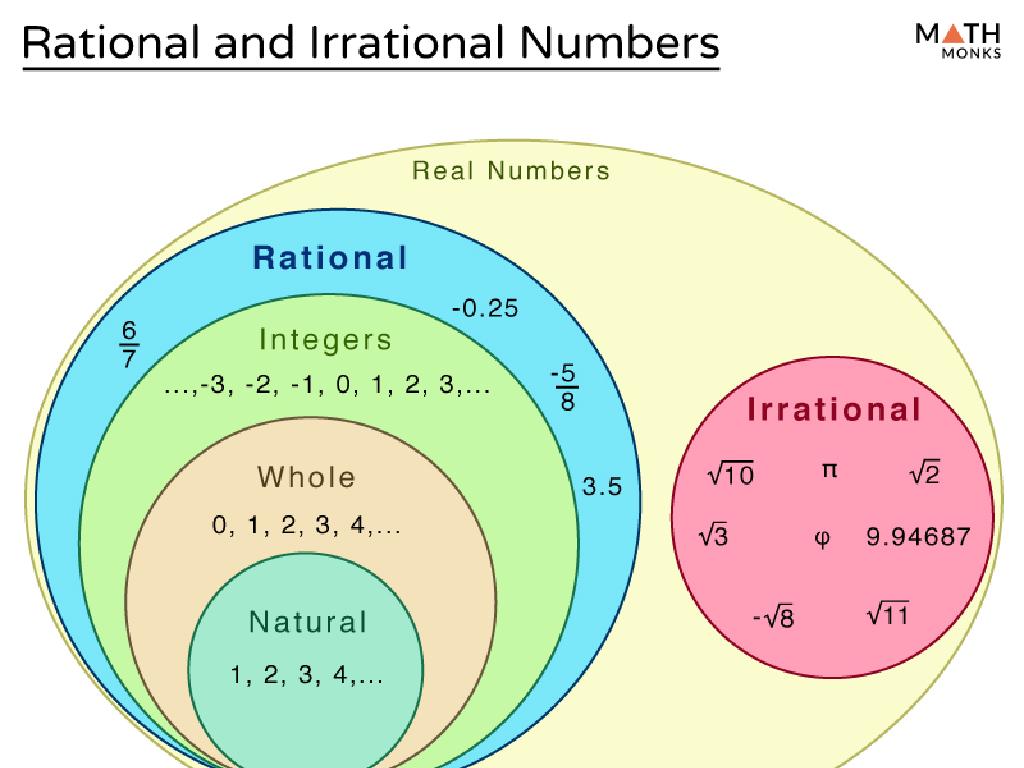Atoms And Molecules
Subject: Science
Grade: Seventh grade
Topic: Density
Please LOG IN to download the presentation. Access is available to registered users only.
View More Content
Welcome to the World of Density!
– Matter is made of atoms & molecules
– Atoms are the building blocks of matter, and molecules are groups of atoms bonded together.
– Density: Mass per unit volume
– Density is calculated by dividing the mass of an object by its volume.
– Density’s role in science
– Understanding density helps explain why objects float or sink.
– Practical applications of density
– Density is used in real-world scenarios, such as oil spills and designing ships.
|
This slide introduces students to the concept of density within the context of atoms and molecules. Begin by explaining that all matter is composed of atoms and molecules, which provides a foundation for understanding density. Clarify that density is a measure of how much mass is contained in a given volume. Emphasize the importance of density in scientific studies, including physics, chemistry, and engineering, and how it helps us understand the behavior of different materials in various environments. Use practical examples like the floating of ice on water or the separation of oil from water due to differences in density to illustrate the concept. Encourage students to think of other examples where density plays a crucial role.
Atoms: The Fundamental Building Blocks
– What is an Atom?
– The smallest unit of matter, indivisible by chemical means.
– Exploring Atom’s Components
– Atoms consist of protons (+), neutrons (0), and electrons (-).
– Atoms Bonding into Molecules
– Atoms connect via bonds to form molecules, the chemical combination of two or more atoms.
– Molecules and Density
– Density depends on how tightly atoms are packed in a molecule.
|
This slide introduces students to the concept of atoms as the basic building blocks of matter. Begin with a definition of an atom, emphasizing its indivisibility in chemical processes. Discuss the three main subatomic particles: positively charged protons, neutral neutrons, and negatively charged electrons. Explain how these particles are arranged within an atom and how atoms bond to form molecules. Highlight that the arrangement and type of atoms in a molecule determine the density of a substance. Use examples like water (H2O) and carbon dioxide (CO2) to illustrate how different atoms combine to form common molecules. Encourage students to think about how the density of different materials might be related to the arrangement of atoms in those materials.
Molecules: When Atoms Join Hands
– Definition of a molecule
– A molecule is formed when two or more atoms bond together.
– Common molecules: H2O, O2, CO2
– Water (H2O), Oxygen (O2), and Carbon Dioxide (CO2) are all molecules made of different atoms.
– Chemical bonds explained
– Atoms are held together in molecules by chemical bonds, like sharing or transferring electrons.
– Bonding’s role in molecule formation
– Chemical bonds determine the structure and properties of a molecule.
|
This slide introduces the concept of molecules to students by explaining how atoms bond to form molecules. It provides examples of simple molecules that are part of everyday life, such as water, oxygen, and carbon dioxide. Emphasize the importance of chemical bonds, which are forces that hold atoms together within a molecule. Discuss how these bonds can be covalent, where atoms share electrons, or ionic, where electrons are transferred from one atom to another. Explain that the type of chemical bond affects the molecule’s properties, such as melting and boiling points, reactivity, and electrical conductivity. Encourage students to think about how the molecules around us are made up of atoms bonded in specific ways to perform various functions.
Exploring Density: Atoms and Molecules
– Density: Mass per unit volume
– Density is how tightly matter is packed together
– Density formula: Á = m/V
– Á represents density, m is mass, V is volume
– Common units of density
– Grams per cubic centimeter (g/cm³) or kilograms per cubic meter (kg/m³)
– Significance of density in science
– Determines if objects will float or sink in a fluid
|
This slide introduces the concept of density, a fundamental property in science that describes how much mass is contained in a given volume. Start by explaining that density can help us understand why some objects float while others sink. Introduce the formula for density and ensure students are comfortable with the concept of mass and volume. Discuss the common units used to measure density, such as grams per cubic centimeter for solids and liquids, and kilograms per cubic meter for larger quantities or gases. Emphasize the importance of density in various scientific contexts, such as material science, engineering, and environmental science. Provide examples like oil floating on water or a heavy metal sinking to demonstrate density in action.
Calculating Density
– Measuring mass and volume
– Use a scale for mass and graduated cylinder for volume
– Density of a cube example
– Calculate density with formula: density = mass/volume for a cube
– Density practice problem
– Apply the formula to find the density of a given block
– Understanding density’s role
|
This slide introduces the concept of density and how to calculate it, which is crucial for understanding matter’s properties. Start by explaining how to measure mass using a scale and volume using a water displacement method in a graduated cylinder. Then, walk through a worked example of calculating the density of a cube by applying the formula density = mass/volume. Provide a practice problem for students to calculate the density of a rectangular block, reinforcing the concept. Emphasize that density helps us understand how tightly packed the matter is in an object. Encourage students to think about how objects of different densities might behave in water.
Density in Action: Float or Sink?
– Understanding buoyancy
– Objects float or sink based on their density compared to the fluid they’re in.
– Comparing water and ice density
– Ice is less dense than liquid water, which is why ice floats.
– Density’s role in daily life
– Density explains why oil floats on water and why heavy objects like bricks sink.
– Experimenting with density
|
This slide aims to explain the concept of density and its practical implications in everyday life. Begin by discussing buoyancy and why some objects float while others sink, relating to their density compared to the surrounding fluid. Introduce the concept of water’s unique property where its solid form (ice) is less dense than its liquid form, which is a rare occurrence in nature. Highlight how density plays a crucial role in various everyday phenomena, such as oil floating on water or why certain materials are used for flotation devices. Engage students with a simple experiment to observe density by having them drop various objects in water to see which float or sink, and then predict the outcome before testing other liquids like oil or syrup.
Class Activity: Exploring Density
– Gather materials for the experiment
– Make predictions on density
– Will water, oil, stone, or cork float or sink?
– Perform the density experiment
– Use the graduated cylinder to test each item
– Observe and document the outcomes
– Record which items float or sink and why
|
This class activity is designed to help students understand the concept of density in a practical way. Provide each group with a graduated cylinder, water, oil, a stone, and a cork. Before conducting the experiment, ask the students to predict whether each item will float or sink when placed in water and to justify their predictions based on their understanding of density. During the experiment, students should carefully observe the behavior of each item in water and record their observations. Discuss the results as a class, focusing on the density of each material and why some items float while others sink. Possible variations of the experiment could include using different liquids or objects of various sizes and shapes to further explore the concept of density.
Wrapping Up: Density’s Role in Science
– Recap: What is Density?
– Density is mass per unit volume, important for understanding matter.
– Class Activity Results
– Review the density experiment outcomes from our activity.
– Discussing our Findings
– Analyze why objects sank or floated in relation to density.
– Q&A Session
|
As we conclude, revisit the definition of density and its significance in the study of matter, emphasizing how it helps predict the behavior of substances in different environments. Reflect on the class activity, discussing the observed results and what they reveal about the density of various materials. Encourage students to think critically about why certain objects sank or floated and how this relates to their densities. Open the floor for a Q&A session, addressing any uncertainties and reinforcing key concepts to ensure a solid understanding of density and its applications.





